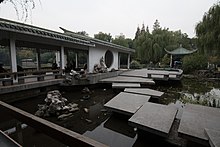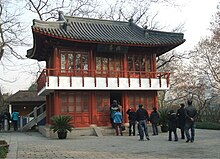Lu Xun Park
| Lu Xun Park 鲁迅 公园, Lǔ Xùn Gōngyuán |
||
|---|---|---|
| Park in Shanghai | ||

|
||
| Basic data | ||
| place | Shanghai | |
| District | Hongkou | |
| Created | 1905 | |
| Technical specifications | ||
| Parking area | 22.37 ha | |
|
31 ° 16 '22.7 " N , 121 ° 28' 52.4" E
|
||
The Lu Xun Park ( Chinese 鲁迅 公园 , Pinyin Lǔ Xùn Gōngyuán ; formerly: Hongkou (Hongkew) Park ) is an urban park in the Hongkou district of Shanghai in the People's Republic of China .
location
The park is located on East Jiangwan Road, just behind the Hongkou Stadium. The area is bordered by Guangzhong Road in the north, Ouyang Road in the northeast, Tian'ai Road in the southeast, Sichuan North Road in the south and East Jiangwan Road in the west. Lu Xun Park is north of Duolun Street, a historic street that is now a car-free zone.
history
The area was initially developed as a shooting range in 1896 , at that time outside the city limits. In 1905 a sports park was added, and further leisure facilities were added by 1909. The park was expanded in the style of the English park and in 1922 was named "Hongkou Park". On April 29, 1932, the Hongkou Park bomb attack occurred . During a celebration to mark Emperor Hirohito's birthday , Korean nationalist Yun Bong-gil detonated a bomb in the park, killing or injuring several senior figures in the Imperial Japanese military . In 2003 a memorial for the attack was opened in the park with the support of the Chinese and Korean governments.
After the withdrawal of the Japanese troops in 1945, the park was renamed "Zhongzheng Park", and in 1950 it got its old name "Hongkou Park" back.
In 1988 the park was named after the Chinese writer Lu Xun , who lived nearby for the last few years of his life and is buried in the park.


